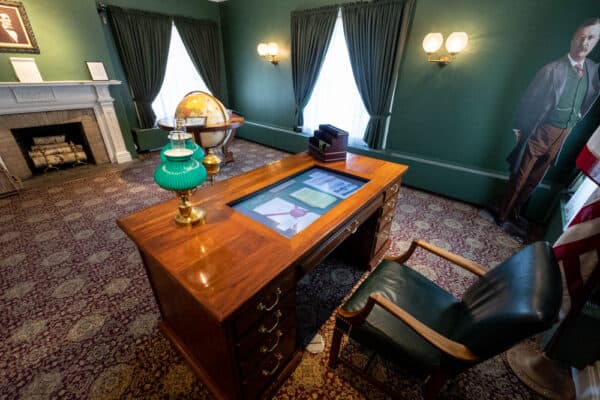I always love finding little-known history when I’m traveling, and one such spot I had a chance to visit was the Theodore Roosevelt Inaugural National Historic Site in Buffalo.
While it’s widely known that presidential inaugurations take place on the steps of the Capitol in Washington, D.C., when emergency inaugurations have taken place after the death of a president, they take place wherever the vice president happens to be. That’s why, in 1901, Theodore Roosevelt became president in the parlor of a house in Buffalo, New York.
Today, that home in the Allentown neighborhood along Delaware Avenue is open for visitors to tour. These tours are great as they cover not only this home and Buffalo’s place in this historic moment, but also do a great job covering the challenges and successes of Roosevelt’s first days as president.

Visits to the home are by guided tour, which start in the gift shop and last about an hour. These are offered every 30 minutes throughout the operating day with the last tour leaving at 3:30p.
The tour starts with a really great overview of the 1901 Pan-American Exposition in Buffalo. It was at this exposition that President William McKinley was fatally wounded, which started the events that led to Roosevelt being inaugurated in the home.

I really enjoyed the way that this section and really the entire museum was presented. There are many fantastic visual elements throughout the space, and several very well-done media displays, including some video of the Pan-American Exposition.
After learning about the exposition and the shooting of President McKinley, the museum shifts to the story of Theodore Roosevelt.
When McKinley was shot, Roosevelt was vacationing in Vermont. He rushed to Buffalo to see the president, but thinking that he was recovering, soon left and went to the Adirondacks to resume his time away.

While there, however, he learned the president had died, and he rushed back to Buffalo to be inaugurated and handle the necessary affairs. That is how he ended up getting inaugurated in the home of his friend, Ansley Wilcox.
The museum does a great job describing the events of these tumultuous days and offers some really great insight into what must have been going through Roosevelt’s mind as he was preparing to become president.

The highlight of the tour is the parlor of the home, which is where the inauguration occurred. Surprisingly, no photos were taken of the event, but photos were taken soon after, so it is known what the room looked like when Roosevelt became president.
Despite the furniture having been sold at auction in the 1930s, the parlor has been painstakingly recreated to what it would have looked like in September 1901.

In addition to the great information about the Pan-America Exposition, the assassination of President McKinley, and the story of Roosevelt’s inauguration, there is also a bit of information about how Roosevelt handled his first few days in office.
I really enjoyed being able to step into the recreated presidential office, sit behind the desk, and think about how I would have handled some of the issues that President Roosevelt had to handle during his first few days in office.

Once you’ve read the issue, you pick how you would handle it, and then the screen compares your response to what Roosevelt actually did.
If I had one issue in regards to the museum, it’s that the guided tour doesn’t often give you the chance to really read the displays and see the artifacts, especially in the first part of the museum. It’s possible that they would let you have more time in this area if you asked, but it wasn’t something that was offered by the guide.

Overall, though, the Theodore Roosevelt Inaugural National Historic Site is a unique piece of Buffalo, New York, and American history and is quite interesting to visit. If you are a history buff like me, this is definitely a spot you won’t want to miss when looking for things to do in Buffalo.
Looking for more great places to visit nearby? Check out the Millard Fillmore House, the Buffalo History Museum, the Buffalo Naval Park, and the Buffalo Museum of Science.








